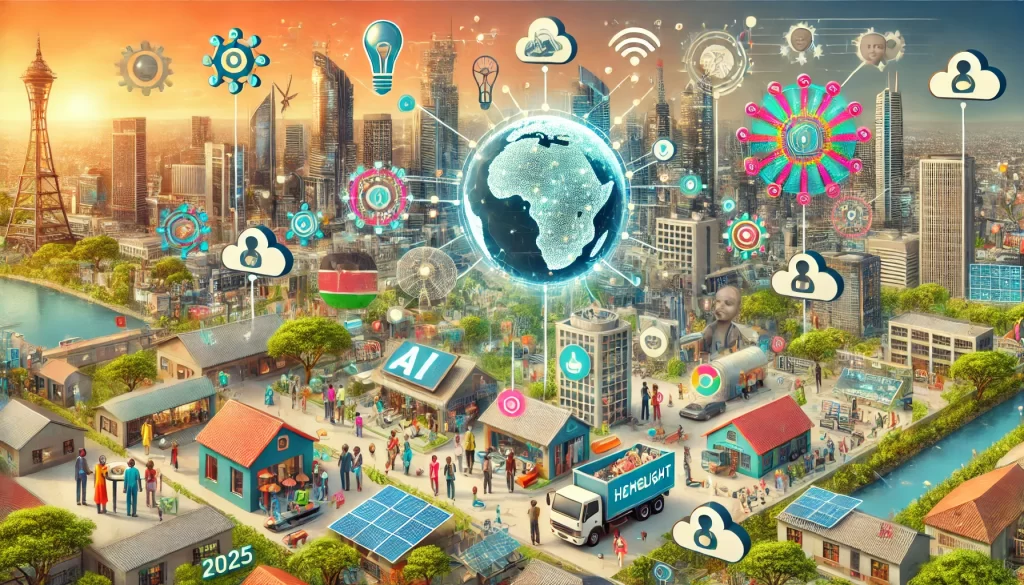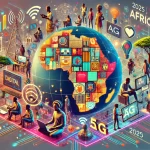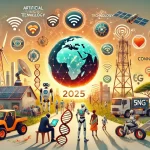The tech and media industries are at a pivotal point, shaped by rapid advancements in artificial intelligence (AI), a growing focus on sustainability, and the emergence of new business models. This article explores these transformative trends, providing insights into how they are redefining the landscape of technology and media. For Kenya, where tech adoption is booming and media consumption is increasingly digital, understanding these shifts is crucial for businesses and consumers alike.
AI Integration: The Ubiquitous Technology
AI has become the cornerstone of technological innovation, deeply embedded in every aspect of tech and media. According to Deloitte’s Tech Trends 2025 report, AI is not just a tool but a foundational element, akin to electricity or HTTP, making processes smarter and more efficient (Deloitte Tech Trends 2025). In the tech sector, AI is transforming IT from a cost center to a competitive differentiator, with CIOs playing a critical role in AI adoption. By 2027, generative AI (gen AI) is expected to be embedded in every company’s digital product or software footprint, across engineering, talent management, cloud financial operations, infrastructure, and cyber risk (Deloitte Tech Trends 2025).
In engineering, AI assists in code generation, automated testing, and data analytics, significantly boosting productivity. For instance, at Google, approximately 25% of new code is developed using AI, and the productivity gain from coding alone is estimated at US$12 billion in the US (Deloitte Tech Trends 2025). In media, AI enhances content creation and personalization, but faces challenges like a hiring gap for AI-related positions, with nearly 50% of positions remaining unfilled, and the need for upskilling through AI-assisted learning paths (Deloitte Tech Trends 2025). For Kenyan tech startups, AI offers opportunities to innovate, but access to talent and infrastructure remains a hurdle.
Sustainability Efforts: Balancing Growth and Environmental Impact
Sustainability is a critical focus, particularly in the context of AI’s energy demands. Deloitte’s TMT Predictions 2025 report highlights the sustainability gap in gen AI data centers, which are expected to consume a significant portion of global electricity. Data centers are forecasted to make up about 2% of global electricity consumption by 2025, driven by power-intensive gen AI applications (Deloitte TMT Predictions 2025).
To address this, the industry is focusing on increasing carbon-free energy sources, improving energy efficiency in gen AI chips and algorithms, and re-balancing compute-intensive AI workloads. Innovations like silicon photonics chips, which consume less energy and produce less heat, are gaining traction, with sales expected to grow at a compound annual growth rate (CAGR) of 25% from 2023 to 2025, reaching US$1.25 billion in 2025 (Deloitte TMT Predictions 2025). Additionally, chiplets are enabling more efficient systems for AI, reducing power consumption through high-speed data transfers and optimized power, performance, and area (PPA). Worldwide advanced packaging revenue based on chiplets is projected to more than double from US$7 billion in 2021 to US$16 billion in 2025 (Deloitte TMT Predictions 2025). In Kenya, where renewable energy adoption is growing, these efforts could align with national sustainability goals, enhancing tech infrastructure.
New Business Models: Innovating for the Future
The media and entertainment industry is witnessing a shift towards new business models, driven by consumer preferences and technological advancements. EY’s Five Media and Entertainment Trends to Watch in 2025 report highlights several key trends (EY Media Trends 2025):
- Experiential Entertainment: There’s a growing trend towards location-based entertainment, such as theme parks, branded districts, cruises, casinos, and live performances. These experiences leverage intellectual property (IP) for high-margin licensing and generate revenue from tickets, food, beverage, and merchandise, helping to offset declines in linear TV.
- AI and Generative AI Adoption: AI is becoming mainstream for content production, distribution, personalized marketing, and monetization. Companies are organizing their data for AI applications, focusing on return on investment (ROI) and risk governance, including fair use, safety, copyright, and talent compensation.
- Direct-to-Consumer (DTC) Streaming Profitability: Streaming services are aiming for profitability with EBITDA margins of 25% or more and robust free cash flow. Success factors include growing ad sales, increasing prices, bundling services, moderating content spending, and controlling costs. Consolidation through joint ventures or mergers and acquisitions is being considered for non-competitive players.
- Linear TV Strategic Crossroads: While 91% of executives in an October 2023 survey saw linear video as key, there’s evaluation of divestment due to cord-cutting, declining subscription fees, ad revenue, and profits. However, retention is considered for cash flow to fund streaming, with potential transactions to validate investor appetite.
- Sports Content and Consumer Experience: Sports content is essential for streaming services, with documentaries and betting programming gaining popularity. Women’s sports and emerging leagues are growing, but viewing is fragmented and expensive for fans, prompting potential sports-centric bundles or technology integration.
These trends indicate a move towards more diversified and consumer-centric business models, leveraging technology to enhance experiences and profitability, with potential for Kenyan media startups to tap into experiential and streaming markets.
Workforce Trends: Adapting to a Changing Landscape
The tech and media workforce is undergoing significant changes, driven by talent shortages, AI adoption, and evolving recruitment strategies. Deloitte’s 2025 Technology Industry Outlook highlights several workforce trends:
- Talent Shortage in Semiconductor Industry: There’s a growing global talent shortage impacting chip design and operations, exacerbated by AI demands. This shortage is critical as the semiconductor industry is pivotal for tech advancements.
- Cloud Talent Shortage: There’s a skills shortage for building and maintaining private cloud infrastructure, especially for gen AI. This indicates a need for specialized talent in cloud computing, which could affect Kenyan tech firms expanding cloud services.
- Developer Use of AI Coding Tools: There’s high adoption of AI coding tools by developers. This trend shows the integration of AI in software development, potentially affecting job roles and skills required, offering opportunities for developers to upskill.
- Impact on Software Talent Recruitment: The use of gen AI tools might necessitate rethinking career progression and engineering talent models. This could lead to changes in how tech companies attract and retain talent, with a focus on continuous learning.
- Reverse Acqui-hiring for Talent: Nontraditional methods like reverse acqui-hiring are being used to quickly assemble specialized skill sets, avoiding conventional mergers and acquisitions (M&A). This approach helps in rapidly acquiring talent without the complexities of traditional M&A, potentially benefiting startups.
- Tech Layoff Trends: Layoffs in the tech industry slowed in 2024 compared to 2023, with 546 tech companies laying off 152,074 workers in 2024, down from 1,193 companies laying off 264,220 in 2023. This indicates a stabilization in the job market, but the overall trend of layoffs remains a concern, impacting tech workers.
These trends underscore the need for tech and media companies to adapt their workforce strategies, focusing on talent acquisition, retention, and upskilling to meet the demands of a rapidly evolving industry, with implications for the global growing tech sector.
The future of tech and media in 2025 is characterized by the pervasive integration of AI, a strong emphasis on sustainability, the emergence of new business models, and significant shifts in workforce dynamics. These trends are not isolated but interconnected, shaping a landscape where innovation and adaptability are key to success. For Kenyan professionals and businesses, staying abreast of these developments is essential to thrive in this dynamic environment. By embracing AI, prioritizing sustainability, innovating business models, and addressing workforce challenges, companies can position themselves for growth and resilience in the years to come.


